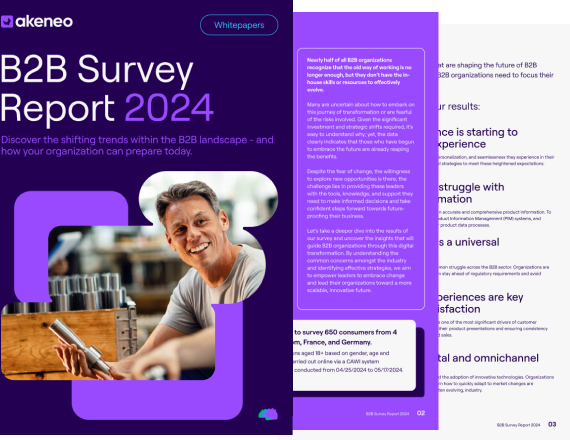The Season of Saving: Strategies to Win Price-Conscious Shoppers
Looking to capture the attention of budget-conscious shoppers this holiday season? Discover how you can empower savvy shoppers to make confident, data-driven decisions ahead of the busiest shopping season of the year, all while boosting sales and building lasting customer loyalty.

With the holiday season just around the corner, shoppers are looking for ways to make their money stretch further than ever before. According to a recent survey we conducted on holiday shopping behavior, 80% of consumers indicated they plan to spend the same or less than they did last year.
But price-conscious doesn’t necessarily mean unwilling to spend. Shoppers are still looking for gifts that are meaningful, high quality, and offer real value. By catering to this mindset and offering products and experiences that empower consumers to make confident, data-driven purchasing decisions, you can cut through the holiday noise and win over the value-seekers without sacrificing your bottom line.
4 Ways to Capture the Attention of the Budget-Savvy Shopper
1. Product bundles
One of the most effective ways to appeal to price-conscious shoppers is by offering bundles of items frequently purchased together at a slightly discounted price, tapping into the desire for a good deal without sacrificing quality. If a shopper adds a bottle of your vanilla-scented shampoo to their basket, you can offer them the conditioner of the same scent for 20% off. The consumer gets a deal on a product they’d be interested in trying, or may have needed to purchase eventually, and your haircare brand gets an extra sale.
Product bundles can also help reduce decision fatigue, which can be overwhelming during the holiday rush. By offering pre-selected groupings of items, you can simplify the shopping experience for customers and guide them toward making quicker, more confident purchasing decisions.
Accurate product data is the key to creating bundles that truly resonate with customers. When your product information is detailed, up-to-date, and well-organized, you can identify which items are frequently bought together, their complementary features, and even customer preferences based on past purchases, allowing you to craft bundles that feel relevant and increasing the likelihood of customers taking advantage of the deal.
2. Personalized discounts
Personalization has become a cornerstone of modern retail strategies, and it’s particularly impactful when it comes to offering discounts. By leveraging browsing and shopping behavior data, you can create personalized offers that feel custom-tailored to each shopper’s needs.
If a customer has been browsing your site for winter boots but hasn’t made a purchase, offering a targeted discount on the boots they’ve shown interest in can be the nudge they need to complete their purchase. Or if a shopper has previously purchased a product from a particular category—say, outdoor gear—rewarding their loyalty with a discount code for tents and sleeping bags could hit the mark.
Product and customer data play a pivotal role in the creation of personalized discounts because they allow retailers to move beyond one-size-fits-all promotions and instead deliver targeted, meaningful offers. By leveraging data, retailers can gain insights into individual customer behavior—such as preferred shopping times, product affinities, and buying frequency. This enables them to predict what types of discounts will most effectively drive conversions, maximizing the impact of promotions.
When data is used effectively, personalized discounts feel less like marketing tactics and more like thoughtful gestures that reflect an understanding of the customer’s needs. Instead of overwhelming customers with irrelevant offers, brands and retailers can present tailored discounts at moments when they are most likely to act, such as after a browsing session or just before a purchasing decision.
2024 Holiday Season Guide
3. Supply chain transparency
Despite an overall trend towards price-consciousness, half of U.S. consumers surveyed said they would pay a premium for sustainably sourced products. Incorporating details like the origin of your materials, the ethical practices behind their sourcing, and the sustainability of your manufacturing process gives shoppers the confidence they need to value-based decisions.
As more consumers seek to align their purchases with their values, particularly around environmental and ethical concerns, the depth and clarity of the product information you provide can be the deciding factor in whether they’re willing to pay full price, or even a premium, for your goods.
Consumers are no longer swayed by vague buzzwords like “green” or “eco-friendly”; they want specifics, and product information provides that transparency. Clearly indicating where raw materials are sourced from or disclosing ethical practices involved in the production process adds a layer of credibility to claims of sustainability.
This transparency doesn’t just enhance trust; it also helps price-conscious shoppers see the long-term value of their investment. They can weigh the benefits of buying higher-quality, responsibly sourced items that may last longer and have a lower environmental impact, versus cheaper, less sustainable alternatives.
4. Resale markets
The rise of resale markets has been a game-changer for retailers, offering an opportunity to cater to budget-conscious consumers who are looking for quality goods at a reduced price. Creating a resale section on your website or in-store, where shoppers can purchase previously owned or returned items, can appeal to those who want to save money while still getting access to premium products.
Resale markets can also help you reduce the costs associated with excess inventory and returns. Instead of writing off returned items, you can give them a second life and sell them to shoppers who are excited to snag a good deal!
For resale initiatives to be successful, retailers must have detailed, accessible, and up-to-date information on the condition, specifications, and purchase or repair history of each item being resold in order to accurately classify and categorize these items for sale. Without this data, it becomes difficult to build trust with customers and ensure that the products in the resale market are accurately described, properly valued, and appealing to buyers.
Reliable product data also ensures that retailers can properly manage inventory for the resale market. By maintaining a database of available resale items, along with their condition, origin, and other pertinent details, retailers can streamline the process of updating their website or store with accurate resale options. This level of organization and transparency is essential to scaling resale operations, reducing operational inefficiencies, and delivering a seamless shopping experience to consumers.
2024 Holiday Shopping Season
This holiday season, price-conscious consumers will be looking for more value, not just lower prices. With the right strategies, you can stand out from the competition and delight value-driven shoppers, all while maintaining your margins and boosting sales during this critical shopping season.
To learn more about the trends impacting the holiday shopping season, you can download the 2024 Holiday Shopping Guide here, complete with expert insights and actionable strategies.
2024 Holiday Shopping Season Guide
From omnichannel optimization to sustainability-driven purchases, discover how to maximize holiday sales and minimize the dreaded post-holiday return season.

 Akeneo Product Cloud
Akeneo Product Cloud
 PIM Manage & Enrich
PIM Manage & Enrich
 SDM - Onboard Suppliers
SDM - Onboard Suppliers
 Syndication - Activate Product Experiences
Syndication - Activate Product Experiences
 Shared Catalogs
Shared Catalogs
 Integrations
Integrations

















